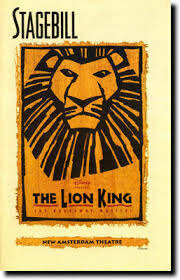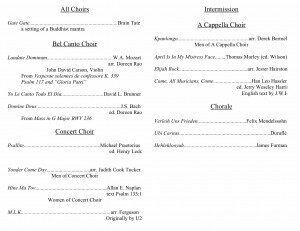
Silk program for Royal performance at the Royal Opera, Covent Garden, 1923 (provided courtesy the British Library)
There are program books and there are program books. We have seen a number of different kinds:
• Programs printed on silk, generally for events of great importance, generally in the presence of royalty.

1980 cover for the Glyndebourne Opera by Erté, with the Knight of the Rose from Der Rosenkavalier

Lion King Stagebill program: outside in color

Lion King Stagebill program: inside in black and white

Playbill Storage Binder
• The simplest program of all – the photocopied sheet of paper

Sample High School Program
Rupert Ridgewell of the British Library is behind an international project on concert programs. Though at first the project was going to index the works being performed, which would have given an unequaled overview of music in performance around the world, they have started their project simply cataloguing what programs are collected where. Some libraries have broken their collections down further, detailing what performer was in a venue on what night, such as this listing for the Manchester Free Trade Hall where you can see the Halle Orchestra in residence, with visits by Tito Gobbi, Marian Anderson, the Amadeus Quartet, and the Vienna Boys Choir, to look at 1952 alone. Dr. Ridgewell has indicated that in the library collections they’ve examined, the earliest program book dates from around 1700, but that the majority fall between 1780 and the present. The largest institutional collection is held by London’s Royal College of Music, with ca. 750,000 items.

Falstaff Program, 1925 (provided courtesy Wulitzer-Bruck, New York)
So, what do you do with your programs? Leave at the theatre? Bring home to throw away? Collect and preserve?


